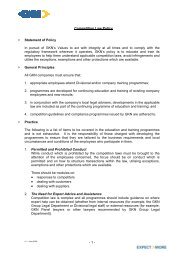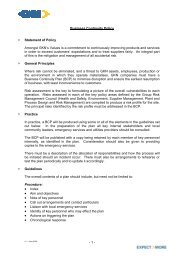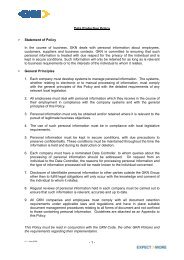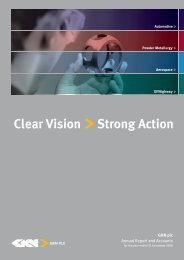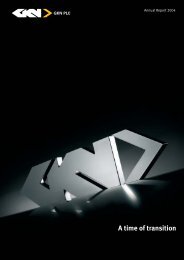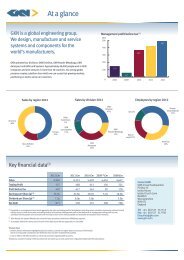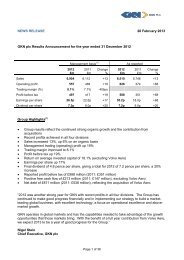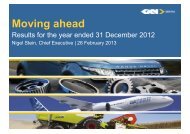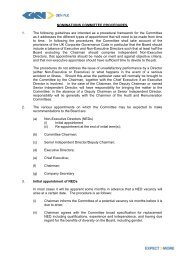Annual Report 2008 in PDF - GKN
Annual Report 2008 in PDF - GKN
Annual Report 2008 in PDF - GKN
Create successful ePaper yourself
Turn your PDF publications into a flip-book with our unique Google optimized e-Paper software.
charges relat<strong>in</strong>g to the Group-wide restructur<strong>in</strong>g programmes announced <strong>in</strong> 2004 and <strong>2008</strong>;<br />
the impact of the annual goodwill impairment review;<br />
asset impairment and restructur<strong>in</strong>g charges which arise from events which are significant to any reportable segment;<br />
amortisation of the fair value of non-operat<strong>in</strong>g <strong>in</strong>tangible assets aris<strong>in</strong>g on bus<strong>in</strong>ess comb<strong>in</strong>ations;<br />
F<strong>in</strong>ancial Statements<br />
profits or losses on bus<strong>in</strong>esses sold or closed which do not meet the def<strong>in</strong>ition of discont<strong>in</strong>ued operations or which the Group views as<br />
capital rather than revenue <strong>in</strong> nature; and<br />
changes <strong>in</strong> the fair value of derivative f<strong>in</strong>ancial <strong>in</strong>struments between the open<strong>in</strong>g and clos<strong>in</strong>g balance sheets and material currency<br />
translation movement aris<strong>in</strong>g on <strong>in</strong>tra-group fund<strong>in</strong>g transactions.<br />
Notes to the F<strong>in</strong>ancial Statements<br />
The Group’s post-tax share of jo<strong>in</strong>t venture profits is shown as a separate component of profit before tax. Material restructur<strong>in</strong>g and impairment<br />
charges are separately identified.<br />
Net f<strong>in</strong>ance costs are analysed to show separately <strong>in</strong>terest payable, <strong>in</strong>terest receivable and the net of <strong>in</strong>terest payable on post-employment<br />
obligations and the expected return on pension scheme assets.<br />
Revenue recognition<br />
Sales<br />
Revenue from the sale of goods is measured at the fair value of the consideration receivable which generally equates to the <strong>in</strong>voiced amount,<br />
exclud<strong>in</strong>g sales taxes and net of allowances for returns, early settlement discounts and rebates.<br />
Invoices for goods are raised when the risks and rewards of ownership have passed which, dependent upon contractual terms, may be at the<br />
po<strong>in</strong>t of despatch, acceptance by the customer or, <strong>in</strong> Aerospace, certification by the customer. Revenue from royalties and the render<strong>in</strong>g of<br />
services is not significant.<br />
Certa<strong>in</strong> bus<strong>in</strong>esses, pr<strong>in</strong>cipally those <strong>in</strong> Powder Metallurgy, recognise an element of revenue via a surcharge mechanism. The surcharge <strong>in</strong>voiced<br />
or credited is generally based on prior period movement <strong>in</strong> raw material price <strong>in</strong>dices applied to current period deliveries. In those <strong>in</strong>stances<br />
where recovery of such <strong>in</strong>creases is guaranteed, irrespective of the level of future deliveries, revenue is recognised, or due allowance made, <strong>in</strong><br />
the same period as the cost movement takes place.<br />
Other <strong>in</strong>come<br />
Interest <strong>in</strong>come is recognised us<strong>in</strong>g the effective <strong>in</strong>terest method. Revenue from dividends is not significant.<br />
Sales and other <strong>in</strong>come is recognised <strong>in</strong> the <strong>in</strong>come statement when it can be reliably measured and its collectability is reasonably assured.<br />
Property, plant and equipment<br />
Property, plant and equipment is stated at cost less accumulated depreciation and impairment charges.<br />
Cost<br />
Cost comprises the purchase price plus costs directly <strong>in</strong>curred <strong>in</strong> br<strong>in</strong>g<strong>in</strong>g the asset <strong>in</strong>to use. Where freehold and long leasehold properties<br />
were carried at a valuation at 23 March 2000, these values have been reta<strong>in</strong>ed as book values and therefore deemed cost at the date of the IFRS<br />
transition. Borrow<strong>in</strong>g costs are not capitalised.<br />
Where assets are <strong>in</strong> the course of construction at the balance sheet date they are classified as capital work <strong>in</strong> progress. Transfers are made to<br />
other asset categories when they are available for use.<br />
Depreciation<br />
Depreciation is not provided on freehold land or capital work <strong>in</strong> progress. In the case of all other categories of property, plant and equipment,<br />
depreciation is provided on a straight l<strong>in</strong>e basis over the course of the f<strong>in</strong>ancial year from the date the asset is available for use.<br />
Depreciation is applied to specific classes of asset so as to reduce them to their residual values over their estimated useful lives, which are<br />
reviewed annually.<br />
The range of ma<strong>in</strong> rates of depreciation used are:<br />
Freehold build<strong>in</strong>gs<br />
Years<br />
Up to 50<br />
Steel powder production plant 18<br />
General plant, mach<strong>in</strong>ery, fixtures and fitt<strong>in</strong>gs 6 to 15<br />
Computers 3 to 5<br />
Commercial vehicles and cars 4 to 5<br />
www.gkn.com 79



